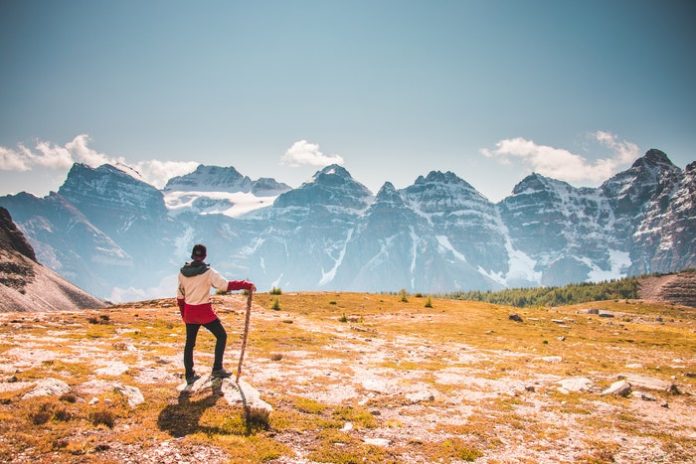Adversity comes in many forms—physical, social, financial, emotional, mental, and spiritual. But despite our differences, the characteristics of overcoming adversity are generally the same. We all need a powerful inner drive, something that pushes us beyond what we think is capable because we are truly set on invoking change. We also need faith, hope, enthusiasm, and determination. My story of overcoming adversity, and not letting fear dictate who I am and what I can do has quite literally enabled me to scale the highest mountains and find success, both professionally and personally.
I was diagnosed with dyslexia and also experienced speech difficulties as a young boy. Needless to say, I didn’t do very well academically, and even had a teacher tell my parents that she thought I would not even graduate from high school. My parents worked a lot, always instilling in me the importance of working hard to earn your success. Their divorce was a common challenge and I struggled at times to make sense of what mattered in life and where my road was going to take me.
While in high school, taking advice from my parents and understanding the importance of a strong work ethic, I began working at a car museum and eventually at a restaurant bussing tables all throughout college. After graduating from Colorado State University, I received a master’s degree in Economics from the University of Michigan and an MBA from the Kellogg School of Management at Northwestern University. In college, I learned how to use the money I earned to invest in stocks, and by the time I graduated, I had saved up a little nest egg. I had found my passion for investing, which eventually led to a fortunate opportunity on Wall Street in corporate finance at JP Morgan in New York City.
As any successful person will tell you, success comes at a price. The price for me was my health. I was utterly focused on my career and because of it, I had gained more than forty pounds and was inherently unhappy with who I had become. Through a bit of reflection and soul-searching, I developed my own philosophy of change and I knew it was time to take a daring leap.
Fast-forward to my accomplishments today—I have journeyed around the world, successfully climbing all Seven Summits. During this time, I proudly served as a vanguard member of a scientific research expedition, discovering 29 new species on Mount Kilimanjaro. Scaling the highest mountains and seeing the world from views that are only known to a few, has deepened my appreciation for promoting environmental and social change.
I am a sponsored Gordini athlete. I credit the success of my second attempt at Everest to my team’s preparedness, at the very least having the best goggles and gloves made for facing the extremes. Thank you Gordini! I am a member of the legendary Explorer’s Club, where I established the Seven Summits Awards Program, rewarding top students with grants for performing healthcare-related field research.
I am an entrepreneur, philanthropist, naturalist, mountaineer and author. My book Die Trying: One Man’s Quest to Conquer the Seven Summits describes my own personal battle against my limitations and shares intricate and raw details of enduring hardship, loss, and finding strength in places I never knew existed.
These incredible, surreal, and at many times heart-breaking experiences have provided me a clear vantage point of who I am and who I strive to be in this world. These experiences have made me a better person, a better businessperson, and a better leader, and I want to share with you five particularly important leadership lessons I have learned from my achievements in climbing the world’s highest peaks.
Five Lessons for the Modern Leader
BUILD YOUR TEAM
I would not have reached the highest peaks in the world without an amazing and dedicated team. In business, just as in mountaineering, the team you build can propel you to greatness. That isn’t to say that there won’t be some stumbles and losses along the way, but if the leaders you surround yourself with share a passion and an inner drive similar to your own, you will find a way to work together to succeed.
Before setting foot on any climbing journey, my team, like most mountaineering teams, had a tough, yet necessary conversation. We laid the ground rules for safety and agreed that it was most important to put the fate of the whole team above any individual.
Creating and abiding by rules such as, “If I die in the death zone or am injured in a debilitating way, leave me there” and “If I am injured, but have energy to assist, please help me continue the journey up or down,” aren’t for the faint of heart.
The pledge you make to your teammates is important, because when things go badly, and most likely they will, everyone must come together to rise up and continue pushing for greatness.

BE PREPARED
I learned a lot about preparedness from climbing mountains. Truthfully, you have to. You either prepare, or you die. One in nine people perish on Mount Everest, and while I know that many of them were prepared physically, it is the emotional and mental pressure that many aren’t prepared for.
I began training months in advance to prepare for my first journey up Mount Everest. I would weight train a couple hours a day, five days a week. I did cardio training five to six days a week, including one full ten-hour training day per week.
To really test my physical and mental abilities, I would perform a 15-hour climb, fasting with little to no food or water for 36 hours straight.
Because we would be climbing in the most extreme cold conditions on the planet, during the winter months I would take a cold shower, fully clothed, and then run around the block many times, preparing my body to fight hypothermia.
Much of my preparation for the climb was extreme, but without extreme preparation, you cannot succeed. This important quality is very much the same in leading a business. Businesses that are not prepared for crisis often do not fare well when those extreme situations arise.
The best leaders are prepared for transformation. Leaders must be comfortable sharing responsibility and letting others lead. The most important thing to remember is that you cannot be prepared for everything, and there will be fear.
One of my favorite quotes is by author Roy T. Bennett. He said, “Fear robs you of your freedom to make the right choice in life that can bridge the gap between where you are and where you want to be. On the other side of fear, lies freedom. If you want to grow, you need to be brave and take risks. If you’re not uncomfortable, you’re not growing.”
BE AUTHENTIC AND TRUSTWORTHY
I have seen businesses fail because they were not being true to their mission or their people. When you get to the top, it may be hard to remember exactly how you got there, but you must keep that perspective and maintain a level of authenticity and trust with your team to stay on the journey and get down the mountain together. As a leader, it is critical to show up for your team every day, no matter the circumstances.
Whether summiting a mountain or running a business, leading your mission with authenticity means you lead with your heart, trusting that the team you have built is completely focused on the results. You cannot be afraid to be direct with your teammates, showing your emotions and vulnerability honestly. This does not make a leader look soft, but alternatively, it breeds confidence and trust.
Sharing our vulnerabilities with the team we have built is key to continuing the climb. The hard discussions we have with our teams about our fears and the “what-ifs” help build team communication and allow others to jump in when you feel you are hitting your limit. Teamwork allows us to persevere through the toughest journeys to ultimately achieve greatness.
PERSEVERE DESPITE ADVERSITY
From a young age, I stared adversity in the eyes. It is gut-wrenching to hear a teacher say that they don’t believe you will graduate from high school. It is extremely hard work to become a successful investment banker when you have dyslexia. And it is more terrifying than you could ever imagine when a teammate dies on the mountain and the only thing getting you to reach the top is the motivation to honor your friend.
My first attempt at Mount Everest was in June 2005. It was one of the latest summit attempts in history, which meant that we risked a lot in attempting the journey. The Khumbu Icefall is a stretch on Everest that poses a lot of danger, and with summer and the monsoon approaching, the Icefall Doctors (Sherpas) normally close this section of the climb.
Climbing Mount Everest was like nothing I could ever prepare myself for emotionally. Mount Everest is just over 29,000 feet high. At approximately 24,000 feet it is known as “the death zone” because your body begins to shut down. I saw more dead bodies on the climb up than I ever thought I would, and unfortunately, one of those was my teammate and friend, Rob Milne, who died instantly.
The journey was tough and my teammates and I did not reach the top of Everest that year. As was decided in our pact, we left Rob’s body on the mountain and brought his possessions back down to his family, one of the hardest things I have ever done in my life.
Two years later, we made our second attempt at Mount Everest. With more preparation and better gear, including my Gordini gloves and goggles, we reached the summit. I am sad to say we did not see Rob’s body, but he was with us in spirit every step of the way.
Perseverance in the most difficult of situations, makes a leader stronger and wiser, and can build confidence in the realistic possibility of achieving ultimate success.
BE CONFIDENT, YET HUMBLE
As an entrepreneur, I have led many teams. There are many times where you may feel uneasy, or the risk of breaking into new territory may incite fear, but you must be outwardly confident in your mission. Confidence is what others look for in a leader. Confidence is what got me and my teammates to the top of those mountains.
On the other side of this coin is humility. Humility is the understanding that sometimes you need to know when to let others lead. And when to listen carefully.
I have been lucky enough to work alongside some of the greatest minds in social and environmental impact. My experiences exploring the highest peaks in each of the seven continents has deepened my appreciation for our planet and every organism living on it.
I know that I cannot do it all, so I took my strengths in entrepreneurship and investing and began investing in those people and companies that are committed to social change. I founded Denali Venture Philanthropy with my wife Meredith to create investment opportunities that promote positive, creative, and sustainable improvements in the lives of all humans.
The most important lesson in leadership is to remember that failure is inevitable, but what you do with that failure is how you and your business will be defined. My father always told me, “You can be an agent of change or a victim of change,” and I believe that if you truly want to lead your team to success, you need to embrace the change, look fear in the eye, and keep on climbing.
Find a Home-Based Business to Start-Up >>> Hundreds of Business Listings.















































